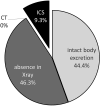A Novel Method to Localize Patency Capsule by Ileocolonoscopy Facilitates Endoscopic Assessment of the Small and Large Intestine in Patients with Crohn's Disease
- PMID: 38857573
- PMCID: PMC11457969
- DOI: 10.1159/000539682
A Novel Method to Localize Patency Capsule by Ileocolonoscopy Facilitates Endoscopic Assessment of the Small and Large Intestine in Patients with Crohn's Disease
Abstract
Introduction: Patients with Crohn's disease (CD) require an assessment of small bowel lesions, while difficulties exist in performing small intestinal examinations, especially in small-sized medical offices. Small bowel capsule endoscopy (SBCE) is handy and can be performed in most clinical settings. The only drawback of SBCE is a requirement of patency testing prior to the exam because it sometimes requires CT scanning to localize the ingested patency capsule (PC), which may be a substantial burden for the patient. We have developed a novel PC detection system named PICS (patency capsule, ileocolonoscopy, and small bowel capsule endoscopy) method by which we can avoid CT scanning. In the PICS method, ileocolonoscopy (ICS) is performed after 30-33 h of PC ingestion and the PC can be localized by ICS in patients who have not excreted the PC, and the entire intestine can be examined in combination with subsequent SBCE without additional bowel preparation. The aim of this study was to assess the usefulness and safety of the PICS method for CD patients.
Methods: CD patients who underwent PICS method from April 2021 to March 2023 were reviewed for clinical data, outcome of PICS method including the rates of PC detection by ICS, the number of patients underwent SBCE, and adverse events. Lewis score was used to assess SBCE results.
Results: The PICS method was performed in 54 patients. The median age of patients was 28.5 years old, and 64.8% of them were ileocolic type. The median disease duration was 10.5 months and 24.1% had history of small bowel resection. Five cases (9.3%) confirmed gastrointestinal patency by ICS, and none of the cases required CT scanning. One patient who could not be confirmed patency by ICS, and the other patient who excreted PC but was found ileal stenosis by ICS did not undergo SBCE. Remaining 52 patients received SBCE, and the median Lewis score of them was 0 (IQR 0, 450). There were no adverse events including small bowel obstruction by PC and SBCE retention in this series.
Conclusion: The PICS method is not only feasible and safe but also convenient to assess disease extent in patients with CD. By localizing PC with ICS, additional CT scanning could be unnecessary for SBCE, which benefits both physicians and CD patients.
Keywords: Crohn’s disease; Ileocolonoscopy; Patency capsule; Small bowel capsule endoscopy.
© 2024 The Author(s). Published by S. Karger AG, Basel.
Conflict of interest statement
There are no financial and other conflicts of interest to disclose.
Figures




Similar articles
-
Long-Term Monitoring and Clinical Implications of Small Bowel Capsule Endoscopy in Patients with Crohn's Disease with Small Bowel Lesions: A Retrospective Analysis.Digestion. 2024;105(5):380-388. doi: 10.1159/000539745. Epub 2024 Jun 10. Digestion. 2024. PMID: 38857583
-
Modified method of patency judgement using patency capsule prior to capsule endoscopy in clinical practice.Sci Rep. 2022 Aug 22;12(1):14335. doi: 10.1038/s41598-022-18569-y. Sci Rep. 2022. PMID: 35995963 Free PMC article.
-
The role of small bowel capsule endoscopy and ileocolonoscopy in patients with nonspecific but suggestive symptoms of Crohn's disease.Eur J Gastroenterol Hepatol. 2016 Aug;28(8):882-9. doi: 10.1097/MEG.0000000000000644. Eur J Gastroenterol Hepatol. 2016. PMID: 27183502
-
Indications and Limitations Associated with the Patency Capsule Prior to Capsule Endoscopy.Intern Med. 2022 Jan 1;61(1):5-13. doi: 10.2169/internalmedicine.6823-20. Epub 2021 Jun 12. Intern Med. 2022. PMID: 34121000 Free PMC article. Review.
-
Small bowel capsule endoscopy and treat-to-target in Crohn's disease: A systematic review.World J Gastroenterol. 2019 Aug 21;25(31):4534-4554. doi: 10.3748/wjg.v25.i31.4534. World J Gastroenterol. 2019. PMID: 31496630 Free PMC article.
References
-
- Samuel S, Bruining DH, Loftus EV Jr, Becker B, Fletcher JG, Mandrekar JN, et al. . Endoscopic skipping of the distal terminal ileum in Crohn’s disease can lead to negative results from ileocolonoscopy. Clin Gastroenterol Hepatol. 2012;10(11):1253–9. - PubMed
-
- Peyrin-Biroulet L, Loftus EV, Colombel J-F, Sandborn WJ. The natural history of adult Crohn’s disease in population-based cohorts. Am J Gastroenterol. 2010;105(2):289–97. - PubMed
-
- Oriuchi T, Hiwatashi N, Kinouchi Y, Takahashi S, Takagi S, Negoro K, et al. . Clinical course and longterm prognosis of Japanese patients with Crohn’s disease: predictive factors, rates of operation, and mortality. J Gastroenterol. 2003;38(10):942–53. - PubMed
-
- Niewiadomski O, Studd C, Hair C, Wilson J, Ding NS, Heerasing N, et al. . Prospective population-based cohort of inflammatory bowel disease in the biologics era: disease course and predictors of severity. J Gastroenterol Hepatol. 2015;30(9):1346–53. - PubMed
-
- Iddan G, Meron G, Glukhovsky A, Swain P. Wireless capsule endoscopy. Nature. 2000;405(6785):417. - PubMed
MeSH terms
LinkOut - more resources
Full Text Sources
Medical
Miscellaneous

